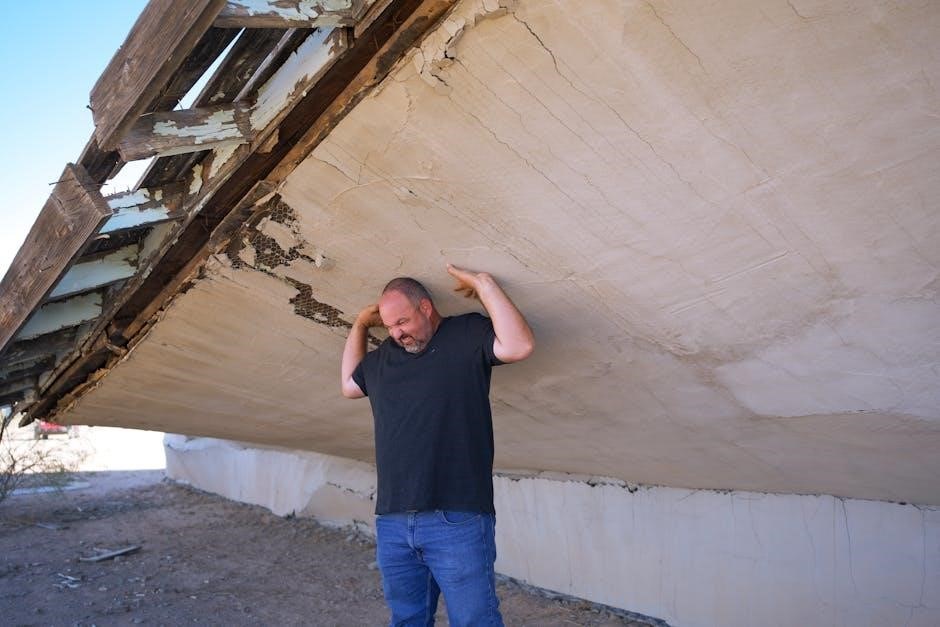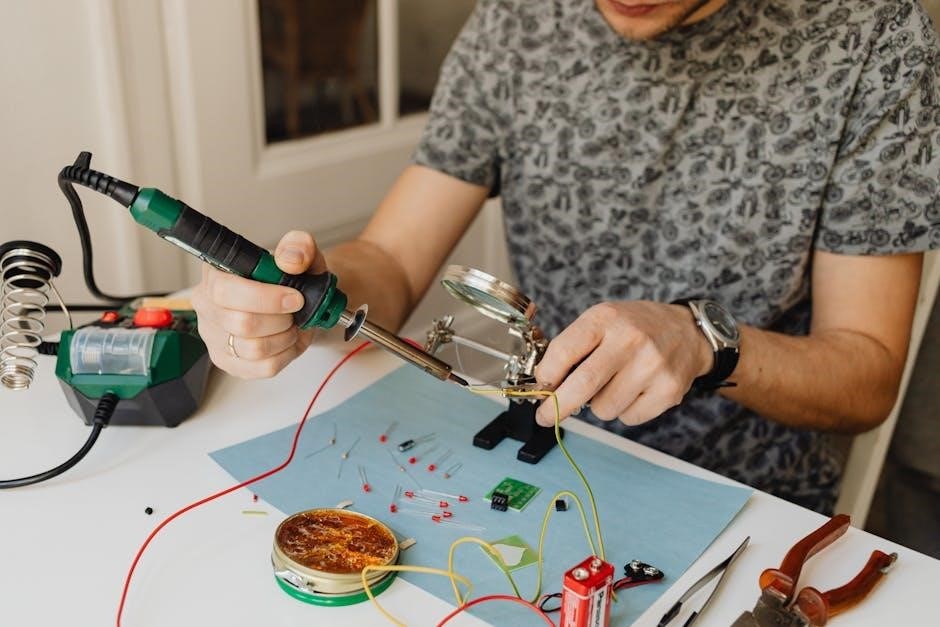Manual retractable awnings are popular for providing shade and protection but often face issues like jamming, misalignment, and durability concerns, affecting their performance and longevity.
1.1 What Are Manual Retractable Awnings?
Manual retractable awnings are outdoor shading systems designed to provide protection from sunlight and weather conditions. They consist of a durable fabric cover stretched over a metal frame, which can be manually extended or retracted using a crank or handle. These awnings are typically mounted above windows or doors and offer versatility in controlling light and shade. Unlike automatic models, manual versions rely on physical operation, making them a cost-effective solution for homeowners. They are often customizable in size, color, and design to suit various architectural styles. While they offer practical benefits like UV protection and energy savings, their manual mechanism can sometimes lead to operational challenges over time.
1.2 Benefits and Popularity
Manual retractable awnings are widely popular due to their ability to provide shade, reduce energy costs, and enhance outdoor living spaces. They offer UV protection, lowering indoor temperatures during summer, and can be retracted during harsh weather, extending their lifespan. Homeowners appreciate their versatility, as they can be customized to match architectural styles and decor. The manual operation is simple and cost-effective, appealing to those seeking affordable shading solutions. Additionally, they add aesthetic value to properties, making them a desirable feature for homeowners. Their popularity stems from a perfect balance of functionality, durability, and affordability, addressing both practical and decorative needs effectively.

Common Installation Issues

Improper mounting, misalignment, and insufficient structural support are common installation issues, leading to instability and premature wear of manual retractable awnings.
2.1 Mistakes During Installation
Common installation mistakes include improper mounting, misalignment, and inadequate structural support. These errors can lead to instability, uneven deployment, and increased wear on the awning mechanism. Additionally, incorrect spring tension and failure to follow manufacturer guidelines often result in operational issues. Many homeowners also overlook the importance of securing the awning frame properly to the building, which can compromise its durability. To avoid these pitfalls, it is crucial to carefully measure and align the awning before installation. Consulting professional installers or following detailed manuals can significantly reduce the risk of these mistakes, ensuring optimal performance and longevity of the awning.
2.2 Importance of Proper Installation
Proper installation is critical for ensuring the structural integrity and functionality of manual retractable awnings. A well-installed awning provides stable shade, protects against weather damage, and enhances the aesthetic appeal of a building. Incorrect installation can lead to reduced durability, uneven operation, and increased risk of damage from wind or rain. Additionally, proper installation ensures safety by preventing accidents caused by collapsing or shifting awnings. It also maximizes energy efficiency by providing consistent shade, reducing the need for air conditioning. Furthermore, a correct setup aligns with manufacturer guidelines, preserving warranties and ensuring optimal performance over time. Professional installation guarantees these benefits, making it a worthwhile investment for homeowners.
Operating Problems
Manual retractable awnings often face operating issues like jamming, misalignment, and uneven rolling. These problems stem from insufficient lubrication, worn parts, or improper handling, leading to reduced functionality and exposure to harsh weather conditions.
3.1 Jamming or Sticking Issues
Manual retractable awnings often experience jamming or sticking issues due to dirt accumulation, lack of lubrication, or misaligned parts. These problems can cause the awning to stop retracting or extending smoothly, leading to difficulty in operation. Over time, this can result in increased wear on the mechanism, potentially causing permanent damage. Regular cleaning and lubrication of moving parts are essential to prevent such issues. Additionally, inspecting the awning’s springs and gears for proper alignment can help maintain smooth functionality. If jamming persists, professional assistance may be required to ensure the awning operates correctly and lasts longer without further complications.

3.2 Misalignment of Awnings
Misalignment is a common issue with manual retractable awnings, often caused by improper installation or wear over time. If the awning’s mounting brackets are not level or securely fastened, the fabric may not align correctly, leading to uneven deployment. This can result in the awning wobbling or sagging, which may compromise its stability and appearance. Additionally, strong winds or settling of the building can shift the alignment, further exacerbating the problem. Regular inspections and adjustments are crucial to prevent misalignment. If left unaddressed, it can cause permanent damage to the awning’s frame or fabric, requiring costly repairs or replacement.

Maintenance Challenges
Manual retractable awnings require regular cleaning and lubrication to function smoothly. Neglecting upkeep can lead to mold growth, jamming, and mechanical failure, reducing their lifespan.
4.1 Cleaning and Upkeep Tips
Regular cleaning is essential for maintaining manual retractable awnings. Use a soft-bristle brush or cloth to remove dirt and debris, ensuring smooth operation. Avoid harsh chemicals, as they may damage fabrics or finishes. Mild soap and water solutions are ideal for deeper cleaning. Allow the awning to dry completely after cleaning to prevent mold or mildew buildup. Lubricate moving parts periodically to reduce friction and wear. Inspect the awning fabric and frame for tears or damage, addressing issues promptly to prevent further deterioration. Proper upkeep prevents jams, extends longevity, and ensures optimal functionality, making manual retractable awnings a reliable and durable shading solution.
4.2 Lubrication Requirements
Lubrication is crucial for smooth operation of manual retractable awnings. Regularly apply silicone-based lubricants to hinges, rollers, and springs to reduce friction and prevent rust. Avoid using oil-based products, as they attract dust and dirt, potentially causing jams. Lubricate moving parts every 3-6 months, depending on usage, to ensure seamless retraction and extension. Proper lubrication extends the lifespan of mechanical components, reduces wear, and minimizes the risk of sticking or misalignment. Always clean the area before applying lubricant to maximize effectiveness. Proper maintenance ensures optimal functionality and longevity of the awning system, preventing costly repairs and enhancing user experience.
Cost Implications

Manual retractable awnings involve costs in installation, maintenance, and repairs, particularly for mechanisms and fabrics, but regular upkeep can reduce long-term expenses and extend durability.
5.1 Installation and Maintenance Costs

Manual retractable awnings require significant upfront investment for installation, with costs varying based on size, material, and labor. Maintenance expenses include cleaning, lubrication, and occasional repairs to moving parts. Regular upkeep is crucial to prevent issues like jamming or fabric damage, which can lead to costly fixes. While initial installation costs may seem high, proper care can extend the awning’s lifespan and reduce long-term expenses. Additionally, high-quality materials and professional installation can minimize future maintenance needs, ensuring durability and functionality over time.

5.2 Repair Costs and Longevity
Repair costs for manual retractable awnings can vary depending on the extent of damage or wear. Issues like jamming, fabric tears, or broken mechanisms often require professional intervention, increasing expenses. While minor repairs may be manageable, repeated problems can lead to higher costs over time. The longevity of these awnings is influenced by material quality, usage, and maintenance. Proper care, such as regular cleaning and lubrication, can extend their lifespan. However, parts like springs and gears may need replacement, and fabric may fade or degrade, necessitating periodic updates. Generally, well-maintained awnings can last 5-10 years, but neglect can reduce durability significantly.

Best Practices and Solutions
Regular cleaning, proper lubrication, and timely repairs are essential for extending the lifespan of manual retractable awnings. Addressing issues early prevents major damage and ensures smooth operation.
6.1 Tips for Users
Regular inspections and maintenance can significantly reduce manual retractable awning issues. Users should clean fabric and frames periodically to prevent dirt buildup. Lubricating moving parts ensures smooth operation and prevents jamming. Always store awnings during harsh weather to avoid damage. Proper alignment and secure fastening are crucial to prevent misalignment. Address minor issues promptly to avoid costly repairs. For complex problems, consulting professionals is recommended. By following these tips, users can extend the lifespan and performance of their awnings, ensuring optimal functionality and durability over time.
6.2 Role of Professional Help

Engaging professionals is crucial for addressing complex issues with manual retractable awnings. Experts can diagnose and repair problems like structural damage or mechanical failures, ensuring safety and functionality. They use specialized tools and techniques for accurate adjustments and replacements. Regular professional maintenance can prevent major breakdowns and extend longevity. Additionally, professionals provide guidance on proper usage and care, enhancing user experience and performance. Their expertise ensures that awnings function optimally, offering reliable shade and protection while maintaining aesthetic appeal. Consulting professionals is a wise investment for resolving and preventing issues effectively.